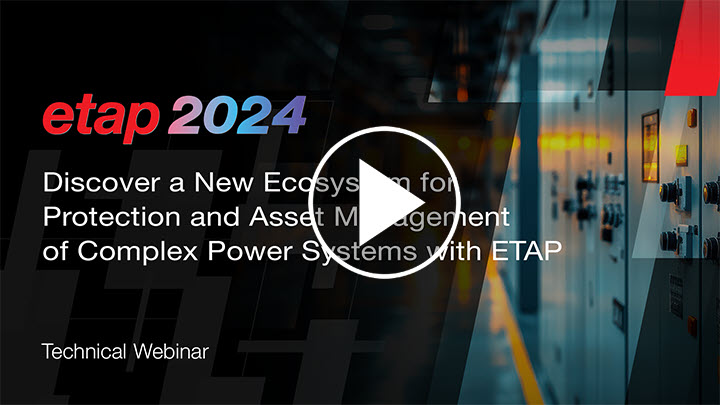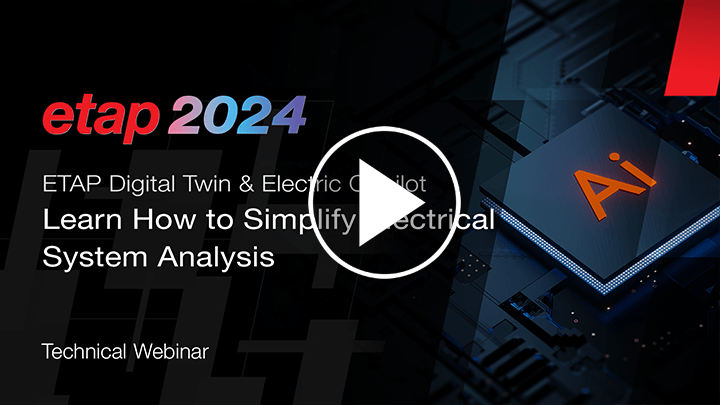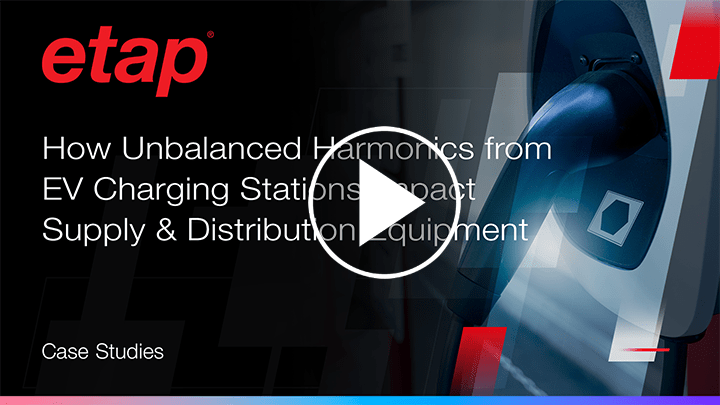Recent Trends
133 Item(s) found

Continuous Intelligence - Design & Operation
- 18:36
- Webinar
ETAP Digital Twin represents virtual models of a real-world power system under various physical and operational conditions. ETAP offers an integrated Electrical Digital Twin platform enriched with intelligent solutions. ETAP Electrical Digital Twin is built on a multi-dimensional foundation, enabling efficient design, analysis, management, operations, and a complete digital transformation of projects while adapting to evolving system changes.

ETAP 21 Release Highlights Part 2 - Monitoring, Control, Automation & Management
- 53:45
- Webinar
In this webinar, we will introduce new features & solutions for Power System Monitoring, Control, Training Simulator, Situational Intelligence, Advanced Protection, Automation Analysis & Asset Management and Digital-Twin Driven Automation & Renewable Energy Power Management. Read more
.png?sfvrsn=139d577c_32)
Design & Operate - Continuous Digital Twin Journey
- 56:04
- Webinar
ETAP Digital Twin is an integral building block in all stages of an electrical system’s life cycle. Join & learn how you can leverage it for shortened design time, validation & transition of digital twin model to operations, early decision support, identification of operation problems & their cause, accelerated engineer & operator training, asset performance monitoring & optimization.
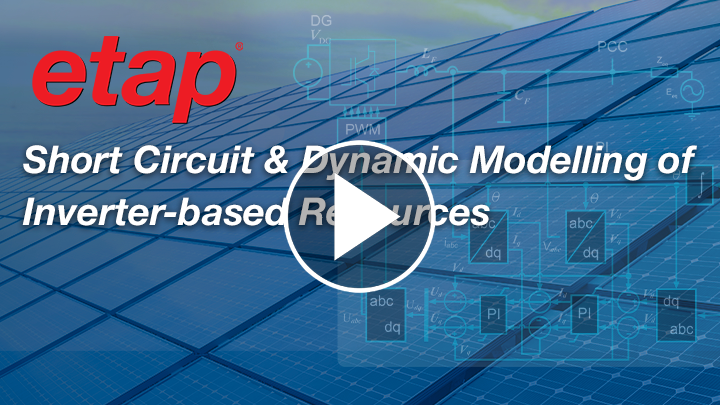
Short Circuit & Dynamic Modelling of Inverter-based Resources
- 56:38
- Webinar
Today’s power systems depend on renewable energy resources to meet their load demand and are typically interconnected through inverters. This webinar demonstrates how inverter-based resources are modeled for short circuit studies. It will also review various dynamic modeling approaches offered by ETAP and discuss merits and limitations of each approach.

ETAP Power System Design Solutions
- 45:06
- Webinar
Learn about ETAP's one-stop solution with intelligent interface views and core capabilities to create, configure, customize, and manage the digital twin model of your electrical power system.

Current Transformer Saturation & Sizing
- 1:02:11
- Webinar
The webinar covers the fundamentals & theory of CT saturation, the effects on equipment, and how to avoid CT saturation for certain applications. It includes a demonstration on how to perform CT saturation analysis and CT sizing using ETAP.
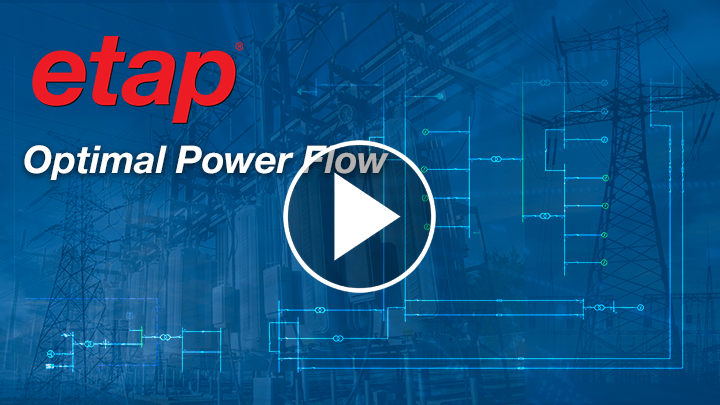
ETAP Optimal Power Flow Analysis - Basics and Application
- 49:15
- Webinar
Reliable, secure and efficient operation of power systems is becoming increasingly important due to drastic changes in technology and industry structure. Learn how Optimal Power Flow enables you to improve the electrical and financial performance of electric power systems while maintaining system resiliency & security.
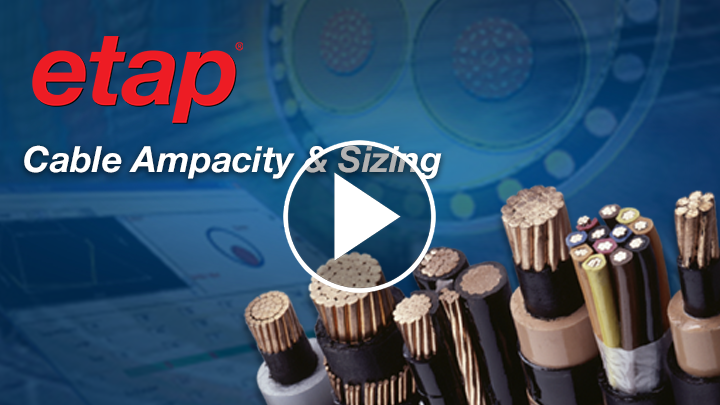
Cable Ampacity & Sizing
- 27:04
- Webinar
Proper sizing and current derating ensures that cables operate to their maximum potential while providing secure and reliable operation. Learn about design and application requirements to properly size and analyze cable systems based on IEEE and North American cable standards and guidelines: IEEE 399, ICEA P-54-440, NEC NFPA 70

ETAP Arc Flash Auto Evaluation Overview
Automated Arc Flash Energy Evaluation - When performing protection and coordination studies it is difficult to anticipate potential arc flash coordination issues due to the differences between the arc and bolted fault currents. Arc Flash Auto solution automatically evaluates arc-flash incident energy and equipment arc flash damage points to quickly resolve these conflicts limiting the number of scenarios required or even removing the need for an isolated arc flash study.
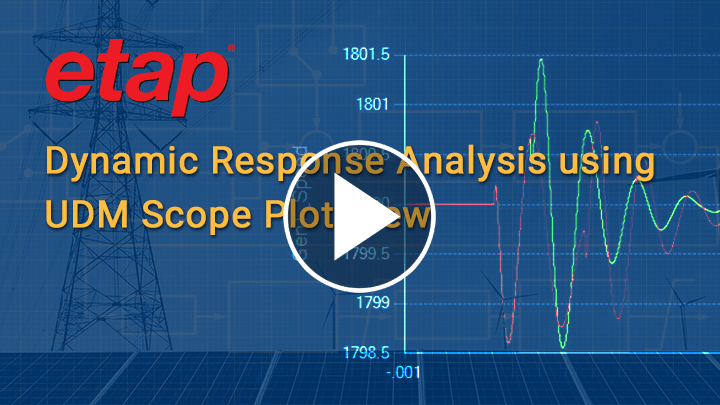
Dynamic Response Analysis using UDM Scope Plot View
- 49:19
- Webinar
ETAP UDM is used to build complex control diagrams for machines & renewable energy systems via a graphical editor and includes solvers for simulating system dynamics. Learn how to use UDM Plot View to compare & analyze these dynamic simulation results from single or multiple cases in a quick & efficient manner.
